Fleet Highlands Cafe: Revenue, Spending, and Variance Analysis Report
VerifiedAdded on 2023/01/10
|9
|2130
|21
Report
AI Summary
This report analyzes the Fleet Highlands Cafe's budget, revenue, and spending variances for March 2019. It begins by outlining the objectives of preparing a budget, including comparing results, providing structure, and guiding managerial decisions. The main body then presents the revenue and spending variances, differentiating between favorable and unfavorable outcomes. The analysis reveals variances in raw materials, wages, utilities, facility rent, insurance, and fuel. The report emphasizes that management should focus on these variances and offers advice to maintain profitability and sustainability, such as developing a strategic plan and conducting a financial stress test. In conclusion, the report summarizes the variances and highlights the importance of financial planning for the cafe's future growth.
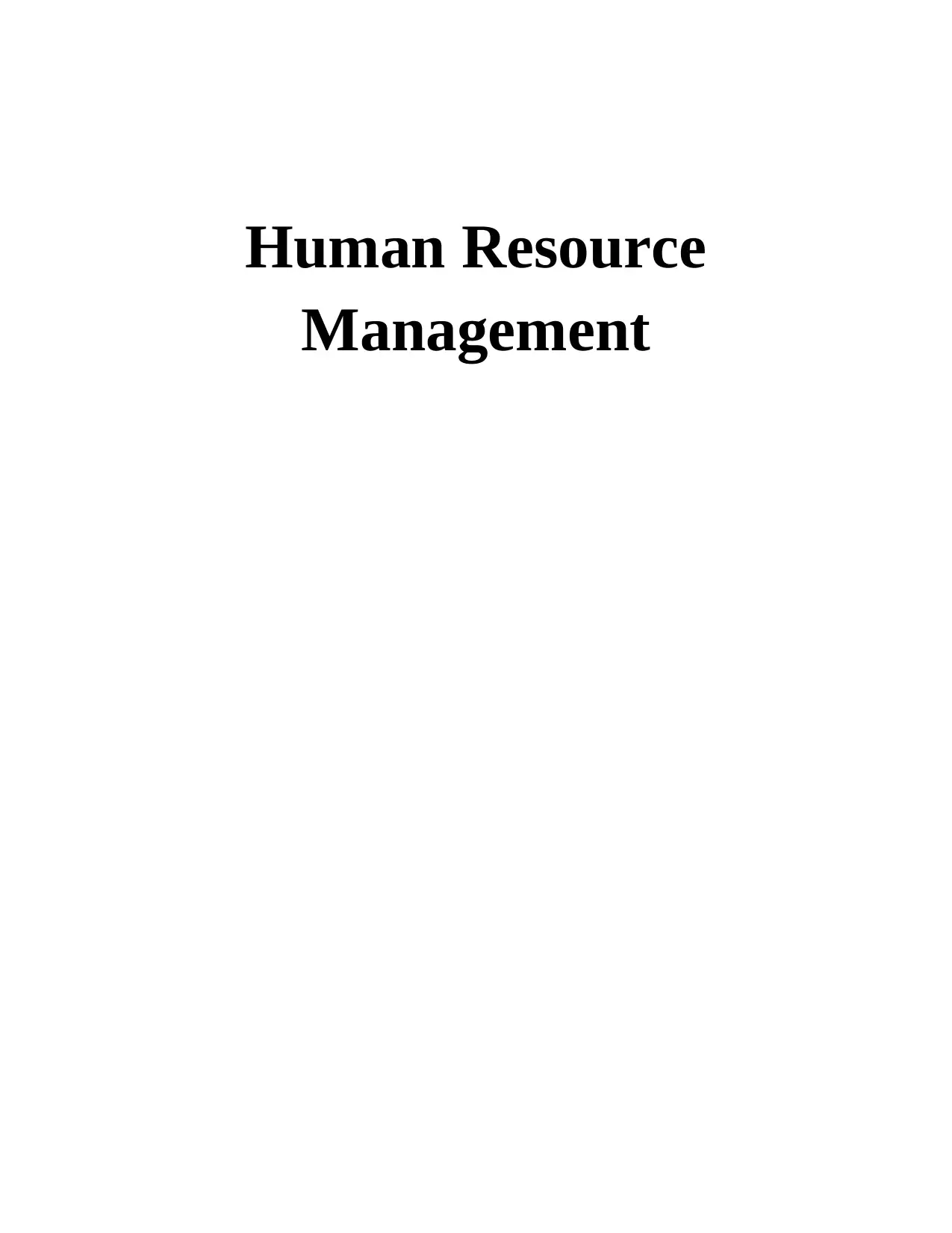
Human Resource
Management
Management
Paraphrase This Document
Need a fresh take? Get an instant paraphrase of this document with our AI Paraphraser

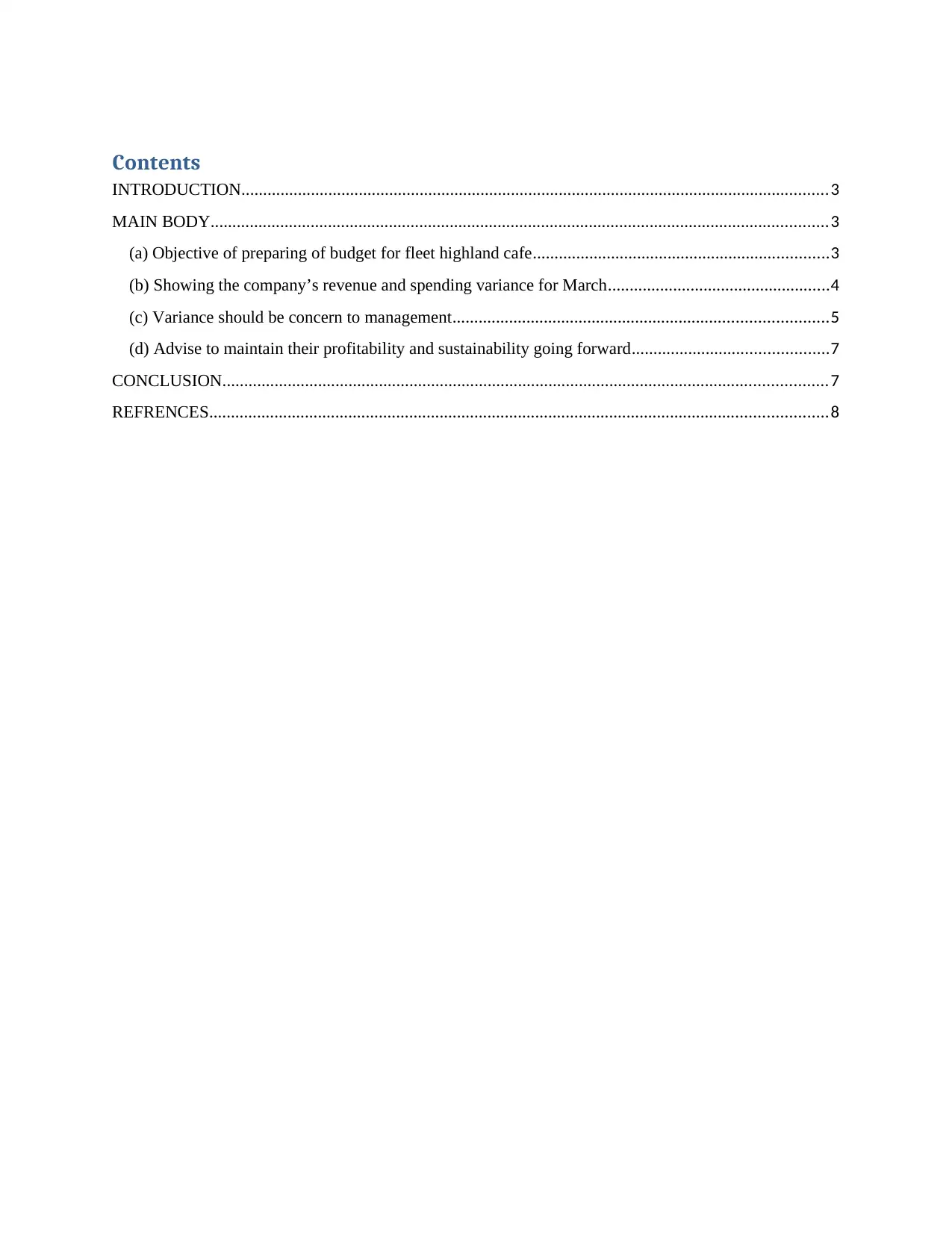
Contents
INTRODUCTION.......................................................................................................................................3
MAIN BODY..............................................................................................................................................3
(a) Objective of preparing of budget for fleet highland cafe....................................................................3
(b) Showing the company’s revenue and spending variance for March...................................................4
(c) Variance should be concern to management......................................................................................5
(d) Advise to maintain their profitability and sustainability going forward.............................................7
CONCLUSION...........................................................................................................................................7
REFRENCES..............................................................................................................................................8
INTRODUCTION.......................................................................................................................................3
MAIN BODY..............................................................................................................................................3
(a) Objective of preparing of budget for fleet highland cafe....................................................................3
(b) Showing the company’s revenue and spending variance for March...................................................4
(c) Variance should be concern to management......................................................................................5
(d) Advise to maintain their profitability and sustainability going forward.............................................7
CONCLUSION...........................................................................................................................................7
REFRENCES..............................................................................................................................................8
⊘ This is a preview!⊘
Do you want full access?
Subscribe today to unlock all pages.

Trusted by 1+ million students worldwide
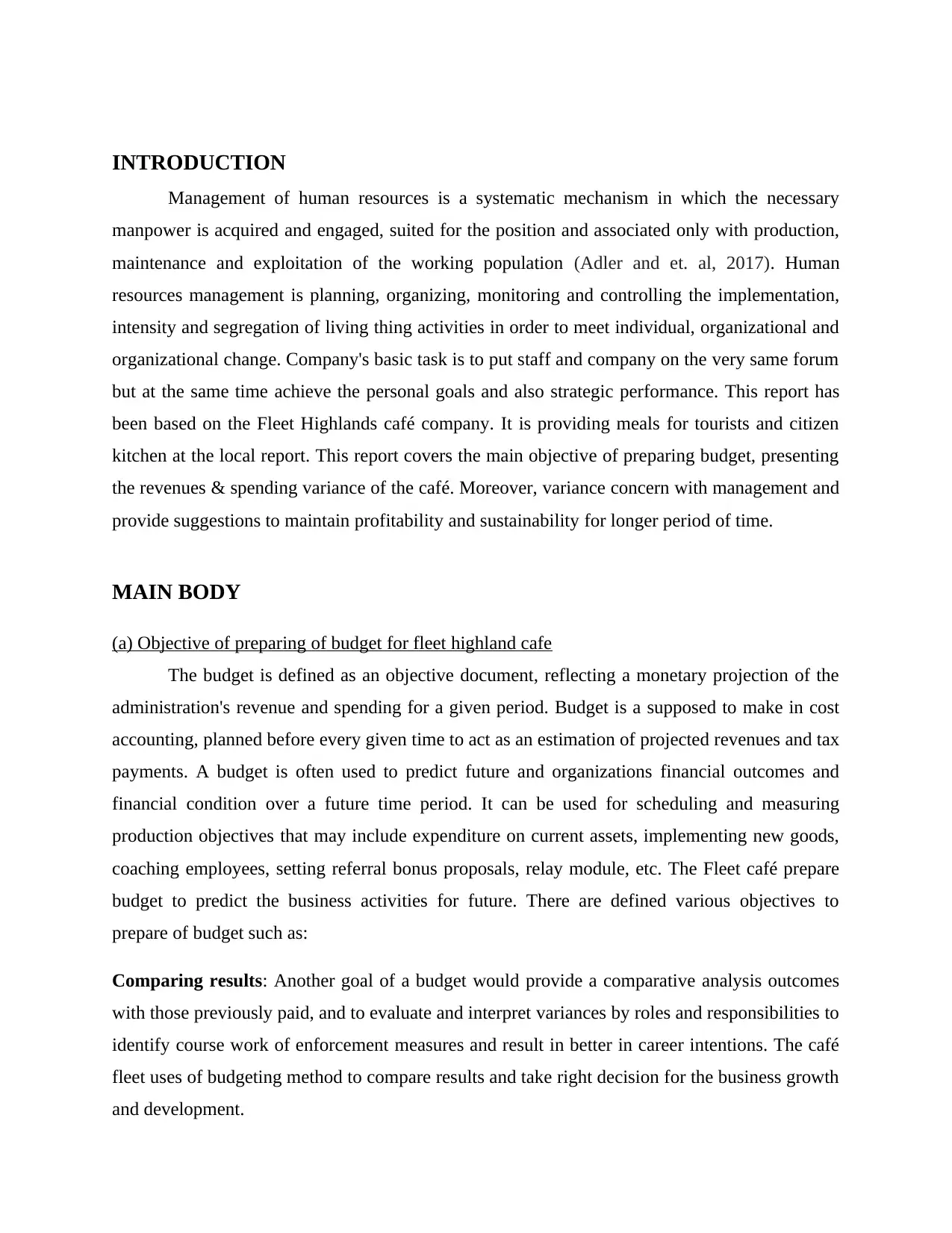
INTRODUCTION
Management of human resources is a systematic mechanism in which the necessary
manpower is acquired and engaged, suited for the position and associated only with production,
maintenance and exploitation of the working population (Adler and et. al, 2017). Human
resources management is planning, organizing, monitoring and controlling the implementation,
intensity and segregation of living thing activities in order to meet individual, organizational and
organizational change. Company's basic task is to put staff and company on the very same forum
but at the same time achieve the personal goals and also strategic performance. This report has
been based on the Fleet Highlands café company. It is providing meals for tourists and citizen
kitchen at the local report. This report covers the main objective of preparing budget, presenting
the revenues & spending variance of the café. Moreover, variance concern with management and
provide suggestions to maintain profitability and sustainability for longer period of time.
MAIN BODY
(a) Objective of preparing of budget for fleet highland cafe
The budget is defined as an objective document, reflecting a monetary projection of the
administration's revenue and spending for a given period. Budget is a supposed to make in cost
accounting, planned before every given time to act as an estimation of projected revenues and tax
payments. A budget is often used to predict future and organizations financial outcomes and
financial condition over a future time period. It can be used for scheduling and measuring
production objectives that may include expenditure on current assets, implementing new goods,
coaching employees, setting referral bonus proposals, relay module, etc. The Fleet café prepare
budget to predict the business activities for future. There are defined various objectives to
prepare of budget such as:
Comparing results: Another goal of a budget would provide a comparative analysis outcomes
with those previously paid, and to evaluate and interpret variances by roles and responsibilities to
identify course work of enforcement measures and result in better in career intentions. The café
fleet uses of budgeting method to compare results and take right decision for the business growth
and development.
Management of human resources is a systematic mechanism in which the necessary
manpower is acquired and engaged, suited for the position and associated only with production,
maintenance and exploitation of the working population (Adler and et. al, 2017). Human
resources management is planning, organizing, monitoring and controlling the implementation,
intensity and segregation of living thing activities in order to meet individual, organizational and
organizational change. Company's basic task is to put staff and company on the very same forum
but at the same time achieve the personal goals and also strategic performance. This report has
been based on the Fleet Highlands café company. It is providing meals for tourists and citizen
kitchen at the local report. This report covers the main objective of preparing budget, presenting
the revenues & spending variance of the café. Moreover, variance concern with management and
provide suggestions to maintain profitability and sustainability for longer period of time.
MAIN BODY
(a) Objective of preparing of budget for fleet highland cafe
The budget is defined as an objective document, reflecting a monetary projection of the
administration's revenue and spending for a given period. Budget is a supposed to make in cost
accounting, planned before every given time to act as an estimation of projected revenues and tax
payments. A budget is often used to predict future and organizations financial outcomes and
financial condition over a future time period. It can be used for scheduling and measuring
production objectives that may include expenditure on current assets, implementing new goods,
coaching employees, setting referral bonus proposals, relay module, etc. The Fleet café prepare
budget to predict the business activities for future. There are defined various objectives to
prepare of budget such as:
Comparing results: Another goal of a budget would provide a comparative analysis outcomes
with those previously paid, and to evaluate and interpret variances by roles and responsibilities to
identify course work of enforcement measures and result in better in career intentions. The café
fleet uses of budgeting method to compare results and take right decision for the business growth
and development.
Paraphrase This Document
Need a fresh take? Get an instant paraphrase of this document with our AI Paraphraser
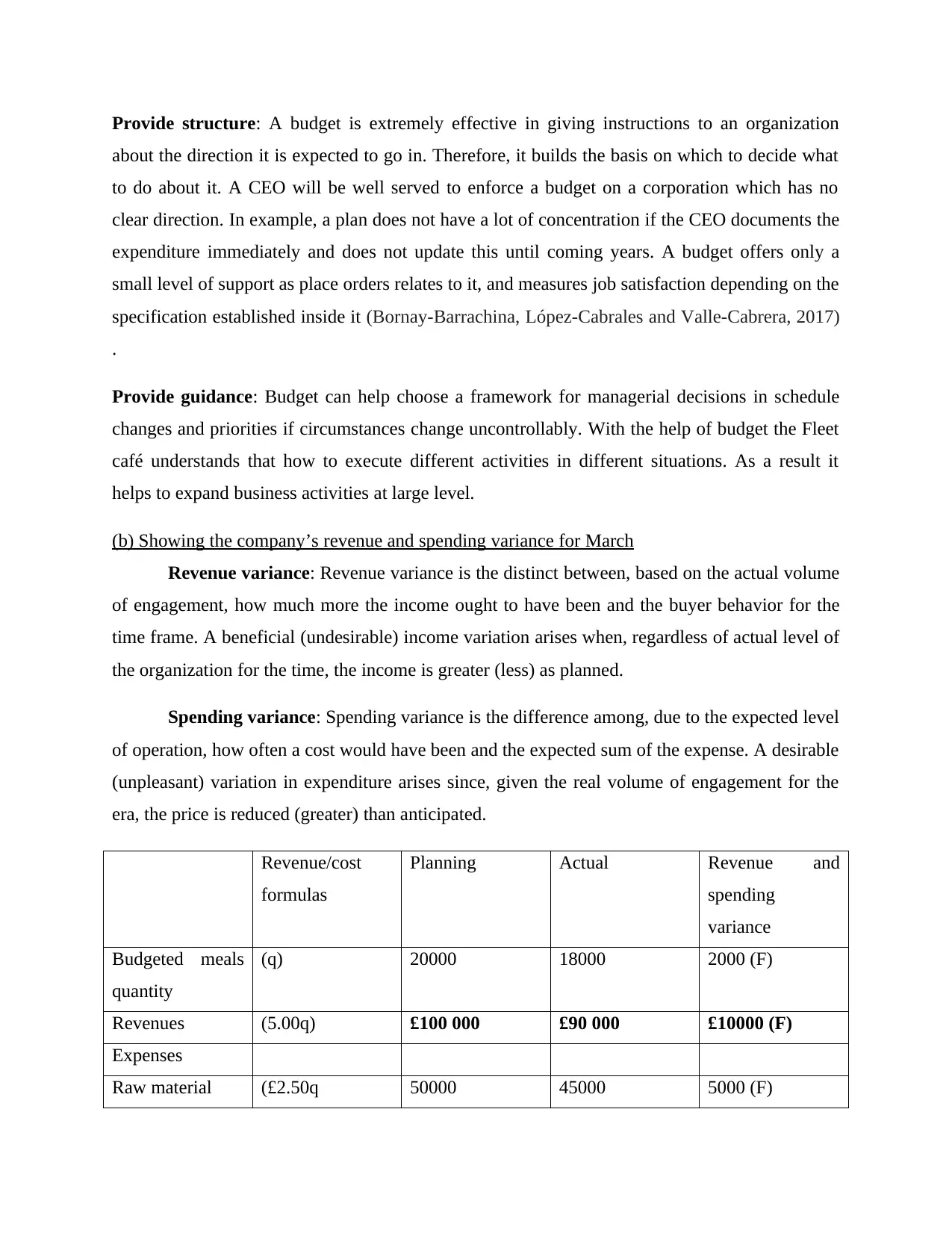
Provide structure: A budget is extremely effective in giving instructions to an organization
about the direction it is expected to go in. Therefore, it builds the basis on which to decide what
to do about it. A CEO will be well served to enforce a budget on a corporation which has no
clear direction. In example, a plan does not have a lot of concentration if the CEO documents the
expenditure immediately and does not update this until coming years. A budget offers only a
small level of support as place orders relates to it, and measures job satisfaction depending on the
specification established inside it (Bornay-Barrachina, López-Cabrales and Valle-Cabrera, 2017)
.
Provide guidance: Budget can help choose a framework for managerial decisions in schedule
changes and priorities if circumstances change uncontrollably. With the help of budget the Fleet
café understands that how to execute different activities in different situations. As a result it
helps to expand business activities at large level.
(b) Showing the company’s revenue and spending variance for March
Revenue variance: Revenue variance is the distinct between, based on the actual volume
of engagement, how much more the income ought to have been and the buyer behavior for the
time frame. A beneficial (undesirable) income variation arises when, regardless of actual level of
the organization for the time, the income is greater (less) as planned.
Spending variance: Spending variance is the difference among, due to the expected level
of operation, how often a cost would have been and the expected sum of the expense. A desirable
(unpleasant) variation in expenditure arises since, given the real volume of engagement for the
era, the price is reduced (greater) than anticipated.
Revenue/cost
formulas
Planning Actual Revenue and
spending
variance
Budgeted meals
quantity
(q) 20000 18000 2000 (F)
Revenues (5.00q) £100 000 £90 000 £10000 (F)
Expenses
Raw material (£2.50q 50000 45000 5000 (F)
about the direction it is expected to go in. Therefore, it builds the basis on which to decide what
to do about it. A CEO will be well served to enforce a budget on a corporation which has no
clear direction. In example, a plan does not have a lot of concentration if the CEO documents the
expenditure immediately and does not update this until coming years. A budget offers only a
small level of support as place orders relates to it, and measures job satisfaction depending on the
specification established inside it (Bornay-Barrachina, López-Cabrales and Valle-Cabrera, 2017)
.
Provide guidance: Budget can help choose a framework for managerial decisions in schedule
changes and priorities if circumstances change uncontrollably. With the help of budget the Fleet
café understands that how to execute different activities in different situations. As a result it
helps to expand business activities at large level.
(b) Showing the company’s revenue and spending variance for March
Revenue variance: Revenue variance is the distinct between, based on the actual volume
of engagement, how much more the income ought to have been and the buyer behavior for the
time frame. A beneficial (undesirable) income variation arises when, regardless of actual level of
the organization for the time, the income is greater (less) as planned.
Spending variance: Spending variance is the difference among, due to the expected level
of operation, how often a cost would have been and the expected sum of the expense. A desirable
(unpleasant) variation in expenditure arises since, given the real volume of engagement for the
era, the price is reduced (greater) than anticipated.
Revenue/cost
formulas
Planning Actual Revenue and
spending
variance
Budgeted meals
quantity
(q) 20000 18000 2000 (F)
Revenues (5.00q) £100 000 £90 000 £10000 (F)
Expenses
Raw material (£2.50q 50000 45000 5000 (F)
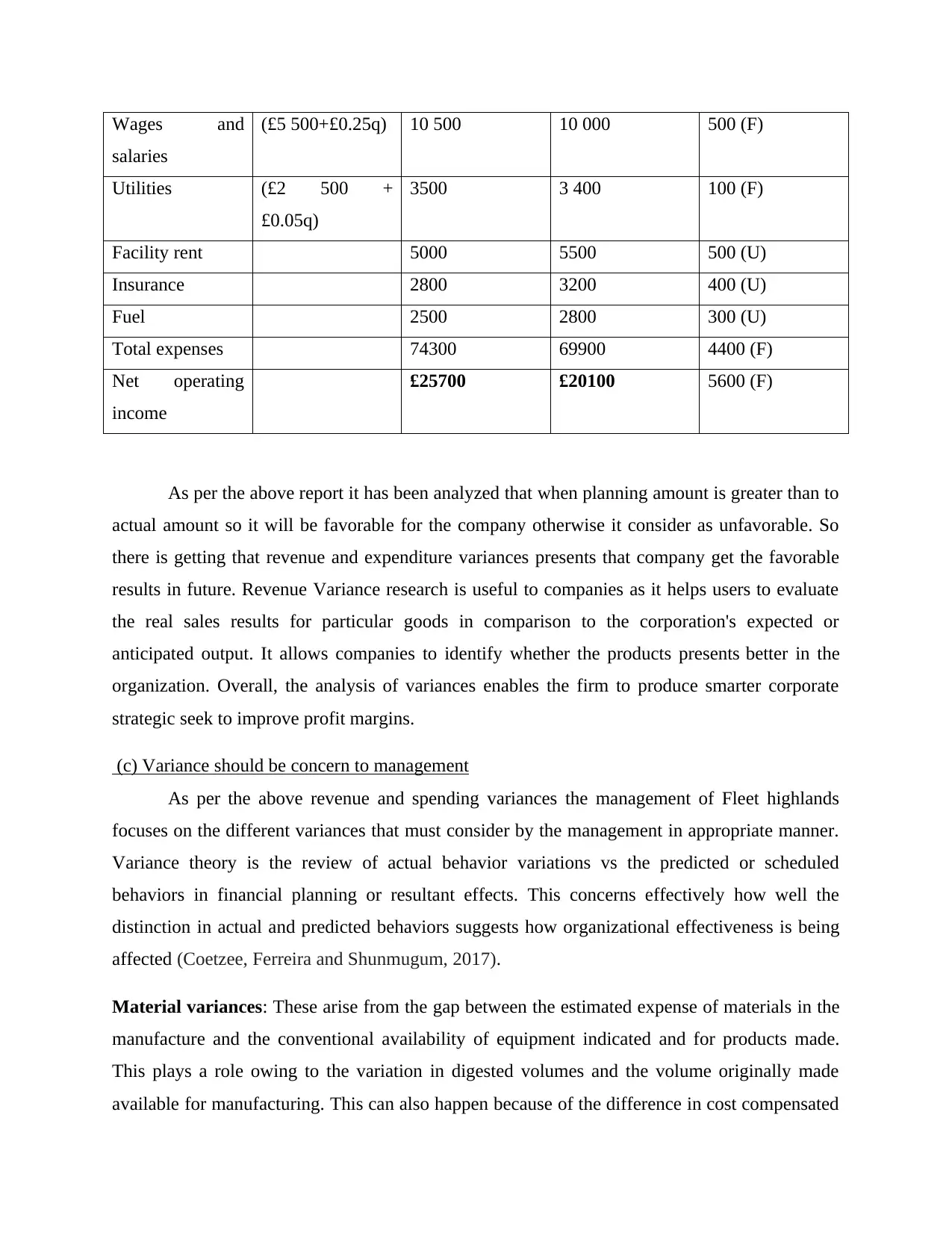
Wages and
salaries
(£5 500+£0.25q) 10 500 10 000 500 (F)
Utilities (£2 500 +
£0.05q)
3500 3 400 100 (F)
Facility rent 5000 5500 500 (U)
Insurance 2800 3200 400 (U)
Fuel 2500 2800 300 (U)
Total expenses 74300 69900 4400 (F)
Net operating
income
£25700 £20100 5600 (F)
As per the above report it has been analyzed that when planning amount is greater than to
actual amount so it will be favorable for the company otherwise it consider as unfavorable. So
there is getting that revenue and expenditure variances presents that company get the favorable
results in future. Revenue Variance research is useful to companies as it helps users to evaluate
the real sales results for particular goods in comparison to the corporation's expected or
anticipated output. It allows companies to identify whether the products presents better in the
organization. Overall, the analysis of variances enables the firm to produce smarter corporate
strategic seek to improve profit margins.
(c) Variance should be concern to management
As per the above revenue and spending variances the management of Fleet highlands
focuses on the different variances that must consider by the management in appropriate manner.
Variance theory is the review of actual behavior variations vs the predicted or scheduled
behaviors in financial planning or resultant effects. This concerns effectively how well the
distinction in actual and predicted behaviors suggests how organizational effectiveness is being
affected (Coetzee, Ferreira and Shunmugum, 2017).
Material variances: These arise from the gap between the estimated expense of materials in the
manufacture and the conventional availability of equipment indicated and for products made.
This plays a role owing to the variation in digested volumes and the volume originally made
available for manufacturing. This can also happen because of the difference in cost compensated
salaries
(£5 500+£0.25q) 10 500 10 000 500 (F)
Utilities (£2 500 +
£0.05q)
3500 3 400 100 (F)
Facility rent 5000 5500 500 (U)
Insurance 2800 3200 400 (U)
Fuel 2500 2800 300 (U)
Total expenses 74300 69900 4400 (F)
Net operating
income
£25700 £20100 5600 (F)
As per the above report it has been analyzed that when planning amount is greater than to
actual amount so it will be favorable for the company otherwise it consider as unfavorable. So
there is getting that revenue and expenditure variances presents that company get the favorable
results in future. Revenue Variance research is useful to companies as it helps users to evaluate
the real sales results for particular goods in comparison to the corporation's expected or
anticipated output. It allows companies to identify whether the products presents better in the
organization. Overall, the analysis of variances enables the firm to produce smarter corporate
strategic seek to improve profit margins.
(c) Variance should be concern to management
As per the above revenue and spending variances the management of Fleet highlands
focuses on the different variances that must consider by the management in appropriate manner.
Variance theory is the review of actual behavior variations vs the predicted or scheduled
behaviors in financial planning or resultant effects. This concerns effectively how well the
distinction in actual and predicted behaviors suggests how organizational effectiveness is being
affected (Coetzee, Ferreira and Shunmugum, 2017).
Material variances: These arise from the gap between the estimated expense of materials in the
manufacture and the conventional availability of equipment indicated and for products made.
This plays a role owing to the variation in digested volumes and the volume originally made
available for manufacturing. This can also happen because of the difference in cost compensated
⊘ This is a preview!⊘
Do you want full access?
Subscribe today to unlock all pages.

Trusted by 1+ million students worldwide
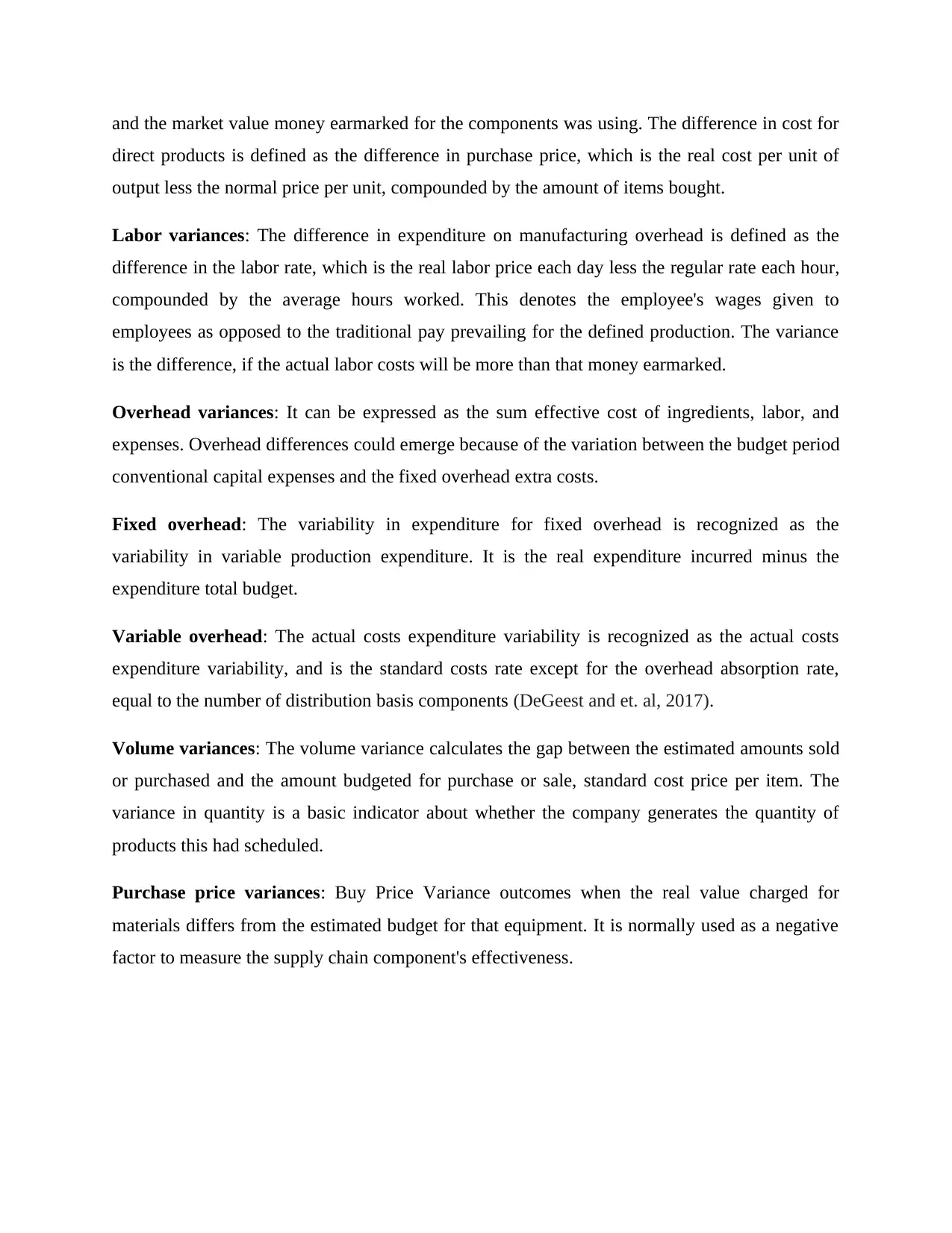
and the market value money earmarked for the components was using. The difference in cost for
direct products is defined as the difference in purchase price, which is the real cost per unit of
output less the normal price per unit, compounded by the amount of items bought.
Labor variances: The difference in expenditure on manufacturing overhead is defined as the
difference in the labor rate, which is the real labor price each day less the regular rate each hour,
compounded by the average hours worked. This denotes the employee's wages given to
employees as opposed to the traditional pay prevailing for the defined production. The variance
is the difference, if the actual labor costs will be more than that money earmarked.
Overhead variances: It can be expressed as the sum effective cost of ingredients, labor, and
expenses. Overhead differences could emerge because of the variation between the budget period
conventional capital expenses and the fixed overhead extra costs.
Fixed overhead: The variability in expenditure for fixed overhead is recognized as the
variability in variable production expenditure. It is the real expenditure incurred minus the
expenditure total budget.
Variable overhead: The actual costs expenditure variability is recognized as the actual costs
expenditure variability, and is the standard costs rate except for the overhead absorption rate,
equal to the number of distribution basis components (DeGeest and et. al, 2017).
Volume variances: The volume variance calculates the gap between the estimated amounts sold
or purchased and the amount budgeted for purchase or sale, standard cost price per item. The
variance in quantity is a basic indicator about whether the company generates the quantity of
products this had scheduled.
Purchase price variances: Buy Price Variance outcomes when the real value charged for
materials differs from the estimated budget for that equipment. It is normally used as a negative
factor to measure the supply chain component's effectiveness.
direct products is defined as the difference in purchase price, which is the real cost per unit of
output less the normal price per unit, compounded by the amount of items bought.
Labor variances: The difference in expenditure on manufacturing overhead is defined as the
difference in the labor rate, which is the real labor price each day less the regular rate each hour,
compounded by the average hours worked. This denotes the employee's wages given to
employees as opposed to the traditional pay prevailing for the defined production. The variance
is the difference, if the actual labor costs will be more than that money earmarked.
Overhead variances: It can be expressed as the sum effective cost of ingredients, labor, and
expenses. Overhead differences could emerge because of the variation between the budget period
conventional capital expenses and the fixed overhead extra costs.
Fixed overhead: The variability in expenditure for fixed overhead is recognized as the
variability in variable production expenditure. It is the real expenditure incurred minus the
expenditure total budget.
Variable overhead: The actual costs expenditure variability is recognized as the actual costs
expenditure variability, and is the standard costs rate except for the overhead absorption rate,
equal to the number of distribution basis components (DeGeest and et. al, 2017).
Volume variances: The volume variance calculates the gap between the estimated amounts sold
or purchased and the amount budgeted for purchase or sale, standard cost price per item. The
variance in quantity is a basic indicator about whether the company generates the quantity of
products this had scheduled.
Purchase price variances: Buy Price Variance outcomes when the real value charged for
materials differs from the estimated budget for that equipment. It is normally used as a negative
factor to measure the supply chain component's effectiveness.
Paraphrase This Document
Need a fresh take? Get an instant paraphrase of this document with our AI Paraphraser
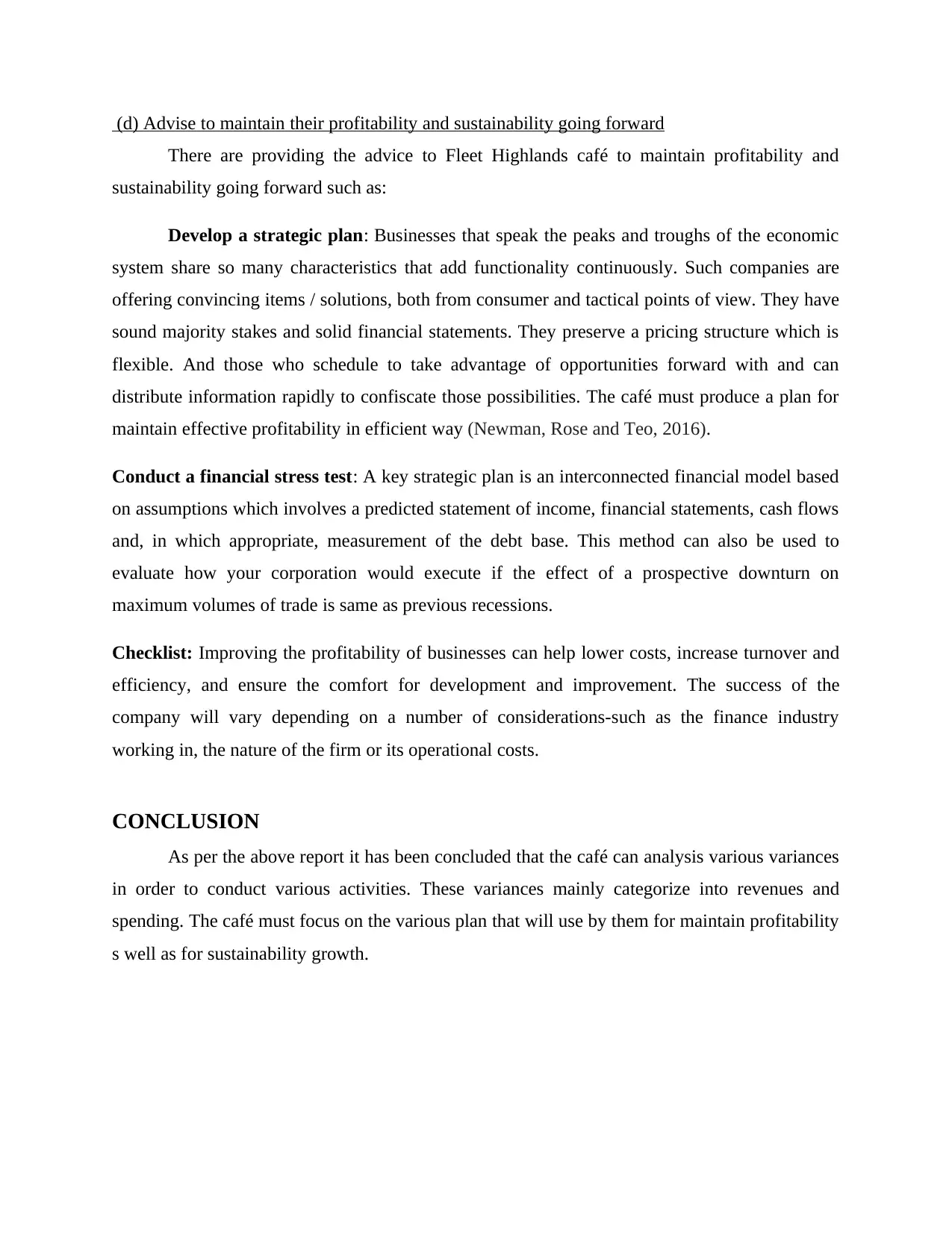
(d) Advise to maintain their profitability and sustainability going forward
There are providing the advice to Fleet Highlands café to maintain profitability and
sustainability going forward such as:
Develop a strategic plan: Businesses that speak the peaks and troughs of the economic
system share so many characteristics that add functionality continuously. Such companies are
offering convincing items / solutions, both from consumer and tactical points of view. They have
sound majority stakes and solid financial statements. They preserve a pricing structure which is
flexible. And those who schedule to take advantage of opportunities forward with and can
distribute information rapidly to confiscate those possibilities. The café must produce a plan for
maintain effective profitability in efficient way (Newman, Rose and Teo, 2016).
Conduct a financial stress test: A key strategic plan is an interconnected financial model based
on assumptions which involves a predicted statement of income, financial statements, cash flows
and, in which appropriate, measurement of the debt base. This method can also be used to
evaluate how your corporation would execute if the effect of a prospective downturn on
maximum volumes of trade is same as previous recessions.
Checklist: Improving the profitability of businesses can help lower costs, increase turnover and
efficiency, and ensure the comfort for development and improvement. The success of the
company will vary depending on a number of considerations-such as the finance industry
working in, the nature of the firm or its operational costs.
CONCLUSION
As per the above report it has been concluded that the café can analysis various variances
in order to conduct various activities. These variances mainly categorize into revenues and
spending. The café must focus on the various plan that will use by them for maintain profitability
s well as for sustainability growth.
There are providing the advice to Fleet Highlands café to maintain profitability and
sustainability going forward such as:
Develop a strategic plan: Businesses that speak the peaks and troughs of the economic
system share so many characteristics that add functionality continuously. Such companies are
offering convincing items / solutions, both from consumer and tactical points of view. They have
sound majority stakes and solid financial statements. They preserve a pricing structure which is
flexible. And those who schedule to take advantage of opportunities forward with and can
distribute information rapidly to confiscate those possibilities. The café must produce a plan for
maintain effective profitability in efficient way (Newman, Rose and Teo, 2016).
Conduct a financial stress test: A key strategic plan is an interconnected financial model based
on assumptions which involves a predicted statement of income, financial statements, cash flows
and, in which appropriate, measurement of the debt base. This method can also be used to
evaluate how your corporation would execute if the effect of a prospective downturn on
maximum volumes of trade is same as previous recessions.
Checklist: Improving the profitability of businesses can help lower costs, increase turnover and
efficiency, and ensure the comfort for development and improvement. The success of the
company will vary depending on a number of considerations-such as the finance industry
working in, the nature of the firm or its operational costs.
CONCLUSION
As per the above report it has been concluded that the café can analysis various variances
in order to conduct various activities. These variances mainly categorize into revenues and
spending. The café must focus on the various plan that will use by them for maintain profitability
s well as for sustainability growth.
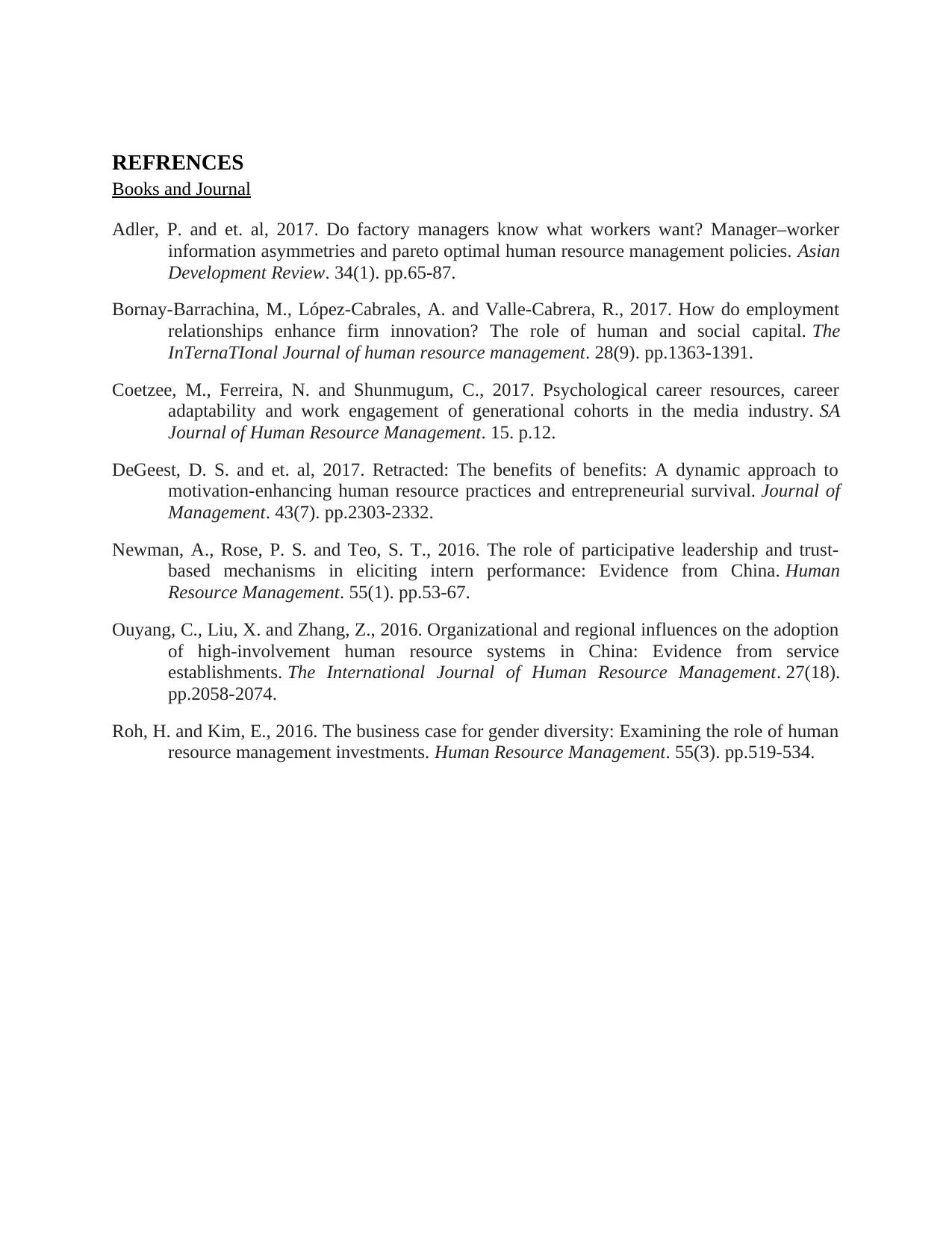
REFRENCES
Books and Journal
Adler, P. and et. al, 2017. Do factory managers know what workers want? Manager–worker
information asymmetries and pareto optimal human resource management policies. Asian
Development Review. 34(1). pp.65-87.
Bornay-Barrachina, M., López-Cabrales, A. and Valle-Cabrera, R., 2017. How do employment
relationships enhance firm innovation? The role of human and social capital. The
InTernaTIonal Journal of human resource management. 28(9). pp.1363-1391.
Coetzee, M., Ferreira, N. and Shunmugum, C., 2017. Psychological career resources, career
adaptability and work engagement of generational cohorts in the media industry. SA
Journal of Human Resource Management. 15. p.12.
DeGeest, D. S. and et. al, 2017. Retracted: The benefits of benefits: A dynamic approach to
motivation-enhancing human resource practices and entrepreneurial survival. Journal of
Management. 43(7). pp.2303-2332.
Newman, A., Rose, P. S. and Teo, S. T., 2016. The role of participative leadership and trust‐
based mechanisms in eliciting intern performance: Evidence from China. Human
Resource Management. 55(1). pp.53-67.
Ouyang, C., Liu, X. and Zhang, Z., 2016. Organizational and regional influences on the adoption
of high-involvement human resource systems in China: Evidence from service
establishments. The International Journal of Human Resource Management. 27(18).
pp.2058-2074.
Roh, H. and Kim, E., 2016. The business case for gender diversity: Examining the role of human
resource management investments. Human Resource Management. 55(3). pp.519-534.
Books and Journal
Adler, P. and et. al, 2017. Do factory managers know what workers want? Manager–worker
information asymmetries and pareto optimal human resource management policies. Asian
Development Review. 34(1). pp.65-87.
Bornay-Barrachina, M., López-Cabrales, A. and Valle-Cabrera, R., 2017. How do employment
relationships enhance firm innovation? The role of human and social capital. The
InTernaTIonal Journal of human resource management. 28(9). pp.1363-1391.
Coetzee, M., Ferreira, N. and Shunmugum, C., 2017. Psychological career resources, career
adaptability and work engagement of generational cohorts in the media industry. SA
Journal of Human Resource Management. 15. p.12.
DeGeest, D. S. and et. al, 2017. Retracted: The benefits of benefits: A dynamic approach to
motivation-enhancing human resource practices and entrepreneurial survival. Journal of
Management. 43(7). pp.2303-2332.
Newman, A., Rose, P. S. and Teo, S. T., 2016. The role of participative leadership and trust‐
based mechanisms in eliciting intern performance: Evidence from China. Human
Resource Management. 55(1). pp.53-67.
Ouyang, C., Liu, X. and Zhang, Z., 2016. Organizational and regional influences on the adoption
of high-involvement human resource systems in China: Evidence from service
establishments. The International Journal of Human Resource Management. 27(18).
pp.2058-2074.
Roh, H. and Kim, E., 2016. The business case for gender diversity: Examining the role of human
resource management investments. Human Resource Management. 55(3). pp.519-534.
⊘ This is a preview!⊘
Do you want full access?
Subscribe today to unlock all pages.

Trusted by 1+ million students worldwide
1 out of 9
Related Documents
Your All-in-One AI-Powered Toolkit for Academic Success.
+13062052269
info@desklib.com
Available 24*7 on WhatsApp / Email
![[object Object]](/_next/static/media/star-bottom.7253800d.svg)
Unlock your academic potential
Copyright © 2020–2025 A2Z Services. All Rights Reserved. Developed and managed by ZUCOL.




